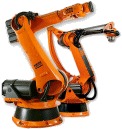
Photo from wikipedia
Abstract Residential air conditioning equipment comprises a significant portion of the total energy consumption of a home. Unfortunately, air-conditioning systems can be susceptible to faulty operation either from installation errors… Click to show full abstract
Abstract Residential air conditioning equipment comprises a significant portion of the total energy consumption of a home. Unfortunately, air-conditioning systems can be susceptible to faulty operation either from installation errors or faults that accrue over the equipment's lifetime. This paper presents a novel automated fault detection algorithm for residential air-conditioning systems that can alert the homeowner of the presence of these faults. The proposed algorithm utilizes only the home's thermostat and outside air temperature to perform automated fault detection over the course of the equipment's lifetime, including immediately after installation. The algorithm uses an extended Kalman filter approach to identify a three-resistance, two-capacitance (3R2C) electrical equivalent thermodynamic model. The identified 3R2C model is used to predict cooling times during a testing period comprising of a series of thermostat drive-cycle experiments. We tested the algorithm on an EnergyPlus R model of a typical residential building in Orlando, Florida. Duct faults, indoor airow faults, and refrigerant undercharge faults were introduced into the building model one at a time. The algorithm was able to accurately determine duct-leak faults, 40% airow faults, 40% undercharge faults, and no-fault cases with an accuracy of 70%, 77%, 82%, and 87%, respectively.
Journal Title: Energy and Buildings
Year Published: 2021
Link to full text (if available)
Share on Social Media: Sign Up to like & get
recommendations!